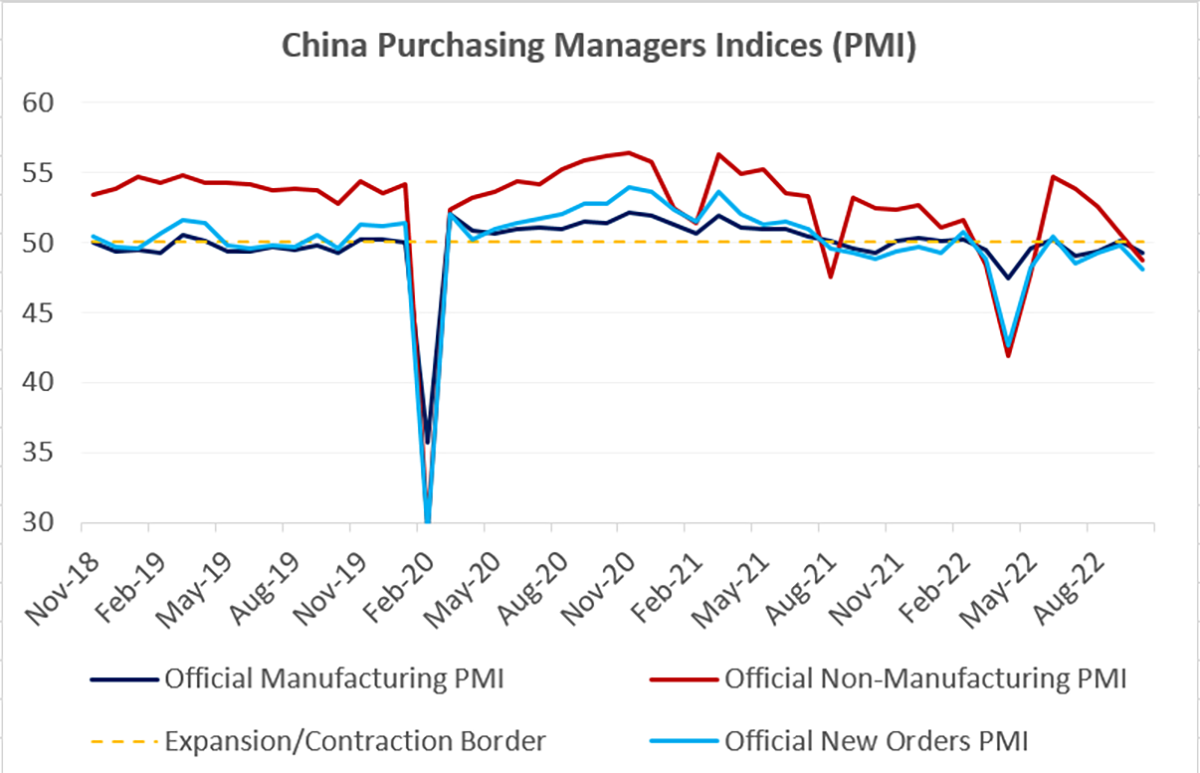China’s Growth Slump – For How Much Longer?
31 October 2022
China Growth Outlook
China’s upside growth surprises do not seem to last. A better-than-expected Q3 GDP print was swiftly followed by the disappointing October activity gauges, most of which ended up in the contraction zone (see chart below). This particular downside surprise was probably not completely unexpected, given that we are dealing with the same set of underlying reasons, including the zero-COVID policy (note that the survey was taken before the latest round of lockdowns) and the housing sector disruptions. The question is what authorities are going to do about it, given (a) that China had already used a lot of policy space (especially on the fiscal side) and (b) that we saw a re-arrangement of priorities during the 20th congress of the communist party (CPC), with security and social stability now ranking higher than the continuity of economic policy (albeit one can argue that growth and social stability are closely related, especially if the labor market pressures persist).
China Policy Space
China is bucking the global policy-tightening trend – an exception among systemically important economies. China is expected to post the largest primary fiscal deficit among major emerging markets (EM) and developed markets (DM) both in 2022 and 2023 (as % of GDP, according to the IMF projections). The central bank made some small interest rate cuts and pledged – on several occasions - to step up credit support for “struggling” sectors. The latest “crop” of weaker-than-expected activity signals generated more calls from observers for “comprehensive policy easing” (or something along these lines). The central bank can do more, for sure. However, the impact of additional easing on the real economy is likely to be muted as long as the zero-COVID policy stays in place.
China Growth Targets
So, are Chinese authorities OK with a slower growth path? The next set of official gatherings - including the Central Economic Work Conference in December - should shed more light on the 2023 official growth target. The IMF sees China expanding by 4.4% next year - well below the customary 5-5.5% threshold – and the CPC’s reference to a more challenging global environment and rising geopolitical risks suggest that weaker growth might be tolerated for longer. China’s upcoming credit and monetary aggregates (out next week) will be closely watched for signals of whether this is indeed the case. Stay tuned!
Chart at a Glance: China Activity Gauges – Stuck in Contraction Zone1

Source: Bloomberg LP
1We believe PMIs are a better indicator of the health of the Chinese economy than the gross domestic product (GDP) number, which is politicized and is a composite in any case. The manufacturing and non-manufacturing, or service, PMIs have been separated in order to understand the different sectors of the economy. These days, we believe the manufacturing PMI is the number to watch for cyclicality.
Related Insights
IMPORTANT DEFINITIONS & DISCLOSURES
This material may only be used outside of the United States.
This is not an offer to buy or sell, or a recommendation of any offer to buy or sell any of the securities mentioned herein. Fund holdings will vary. For a complete list of holdings in VanEck Mutual Funds and VanEck ETFs, please visit our website at www.vaneck.com.
The information presented does not involve the rendering of personalized investment, financial, legal, or tax advice. Certain statements contained herein may constitute projections, forecasts and other forward looking statements, which do not reflect actual results. Information provided by third-party sources are believed to be reliable and have not been independently verified for accuracy or completeness and cannot be guaranteed. Any opinions, projections, forecasts, and forward-looking statements presented herein are valid as of the date of this communication and are subject to change without notice. The information herein represents the opinion of the author(s), but not necessarily those of VanEck.
The views contained herein are not to be taken as advice or a recommendation to buy or sell any investment in any jurisdiction, nor is it a commitment from Van Eck Associates Corporation or its subsidiaries to participate in any transactions in any companies mentioned herein. This content is published in the United States. Investors are subject to securities and tax regulations within their applicable jurisdictions that are not addressed herein.
All investing is subject to risk, including the possible loss of the money you invest. As with any investment strategy, there is no guarantee that investment objectives will be met and investors may lose money. Diversification does not ensure a profit or protect against a loss in a declining market. Past performance is no guarantee of future results.
